PARBICA Conferences
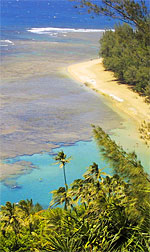
PARBICA 17 REPORT
Pearl Resort, Pacific Harbor Fiji
September 3-7, 2017
I arrived at the Nadi Airport in Fiji full of excitement and optimism. The biennial PARBICA (Pacific Regional Branch International Council on Archives) conference is one of my favorite meetings that I always look forward to attending. Working throughout the Pacific Islands for the past fifteen years I have made many relationships with those that work at cultural heritage organizations and who also enjoy attending the conference every other year. When I left the airport baggage area, I came upon a couple of PARBICAns who had rented a car. As luck would have it, they had space for one more passenger. Thus, I did not waste the opportunity for a free ride. I also have to admit that the two and a half hour drive to the Pearl Resort in Pacific Harbor was a lot more entertaining with conservation than when I usually go by bus and where I just sleep during the entire trip. On the drive to the resort I took in the lovely Fijian countryside. I could not help notice the African tuliptree (Nadi Flame Tree) blooming in the tall trees with their red/orange flowers. When bunched together, they looked like a trail blaze of fire. Only the wobbly trucks overflowing with sugarcane would break my concentration, as they seemed to laboriously waddle over speed bumps. Eventually, we arrived at the Pearl Resort where we had lunch and met other PARBICAns who had already arrived for the conference.
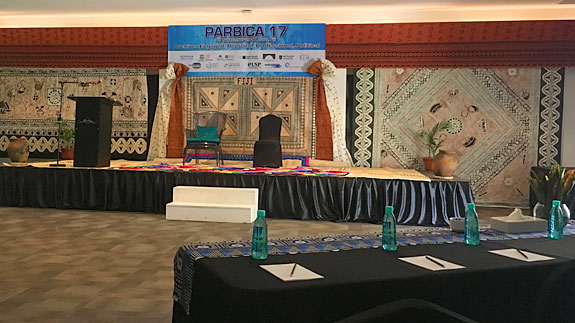
My conference, however, started earlier than most of the other delegates. On Sunday, September 3, I had a meeting with the PARBICA Reference Group that took place for most of the afternoon. The meeting was about adding four new modules to the PARBICA Toolkit. These modules included Vital Records, Disaster Preparedness, Disaster Response and Disaster Recovery. Earlier in the year I had written the three later modules, so it was great to finally present it to the reference group. The modules did go through a couple of preliminary drafts, plus the proofreading from a couple of members of the International Council on Archives Expert Group on Disaster Planning and Emergency Management. But it was very exciting that now the modules were to be evaluated by those that they were solely written for- the Pacific Islands. I lead the discussion of the modules that I had written with the group and the talk was very informative. It allowed me to focus on areas of improvement, and I believe, that only one more draft will be needed before we publish the modules.
The professional program finally started on Monday with an official opening ceremony that included kava making and drinking for a couple of dignitaries, one of which, was Opeta Alefaio of the National Archives of Fiji and the current president of PARBICA. After the ceremony, the keynote speaker, Dr. Jo Hanisch of the National Archives of Australia then spoke to the attendees about the road towards digital sustainability. It was an interesting speech and I particularly enjoyed the part when she traveled to Bangladesh to help introduce computers to villages back in the 1980s and 1990s. Once the Dr. Hanisch finished her talk, the breakout sessions began. Although the breakout sessions typically take place in separate rooms, this conference would be a little different because each session would take place in front of the entire conference delegates. In the morning session we heard talks from Australians, Kari James of the Pacific Manuscript Bureau and Catherine Greene of the Department of Health and Human Services gave a talk about their organizations respectively. Maxine Valentine and Alitia Nasila of the University of South Pacific (USP) in Fiji told us about how the Records Management department came to be at the university. Finally, to round off the morning Naomi Ngirakamerang of the National Archives of Palau and Noa Tapumanaia of the National Archives of Tuvalu enlightened us about new their new archives building respecitvely. Naomi's building just opened a few months prior to the conference, and Noa's building will hopefully be built in 2018.
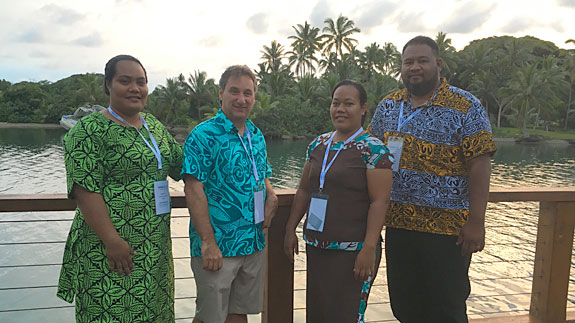
After lunch, we joined together to hear from three more speakers. The first was June Naviti of Vanuatu who talked about the Right to Information in Vanuatu. Jason Flello was up next to tell us more about the status of a new archives building at USP. Jason is head of the Records Management division at USP, and it is hard to believe that this university does not have any sort of an archives building to serve its stakeholders. But Jason is optimistic that groundbreaking will take place next year during the 50th anniversary of the university. The afternoon session ended with Lillie Le Dorre of the Victoria University of Wellington and National Archives New Zealand who talked about her dissertation Climate Change, Resilience and Pacific Archives. No doubt, that this is a very timely topic for the Pacific Islands.
Tuesday brought on another full day of interesting sessions. PARBICA President, Opeta Alefaio, got us started with a talk titled Engage or die: non-traditional response to old problems. I was particularly inspired when he said that archives are about the community and that records should engage with heritage. I also agreed with his statement that archivist and records managers in the Pacific Islands must be proactive and engage with people and other organizations. After Opeta, two speakers from Hawaii then followed on stage. The first was Eleanor Kleiber of the University of Hawaii at Manoa who talked about a project that she has been working on with the Marshall Islands. Her paper was titled Marshall Islands Genealogies: Stakeholders, Cultural Protocol and Repatriation. After her, Koa Luka of the Henry Ku'ualoha Giugni Moving Image Archive of Hawaii spoke about his job with the archive and how he creates metadata for scanned images. After the break, Nick Thieberger form the School of Languages and Linguistics, University of Melbourne talked about the work he does with the Pacific and Regional Archives for Digital Sources in Endangered Cultures, or PARADISEC. Cristela Garcia-Sptiz of the University of California San Diego then examined an interesting project that she had been working on called the Patrol Reports of PNG. The title of her paper was more precisely titled Patrolling the Past: Bringing the Papua New Guinea Colonial Era Reports into the Digital Realm.
I then followed Cristela with a hybrid presentation and workshop about doing oral histories. Much of the oral histories that are currently being done are typically from organizations or universities outside the Pacific Islands. The title of my presentation was Preserving History the Traditional Way: An Oral History Workshop. Before the conference I had believed that my workshop would be done with a small intimate group. Then, just shortly before arrived I learned that the talk would be in front of the entire conference, and thus, that was the reason why it became such a hybrid talk. Although the talk was not about a specific project like the other speakers focused on, it was more of an informative and instructional session with the hope that by the end the delegates were to able to plan, execute, and archive their oral histories. For the next couple of days after the talk, I was approached by many delegates who told me how much they enjoyed the training and had always planned to do some oral histories but was not sure how to start or what it entailed. This really pleased me because I had a suspicion that the interest to produce oral histories was very much prevalent throughout the Pacific Islands. And why not? The islands are traditionally oral societies to begin with. Perhaps, the next step will be draw-up some guidelines or procedures for Pacific Islands cultural heritage organizations regarding oral histories to reference when they start an program or project.
In the afternoon there was only one talk before we engaged in the PARBICA General Conference. Tukul Kaiku of the University of Papua New Guinea and Simiang Bunem of the Department of Implementation and Rural Development of Papua New Guinea talked about a case study titled Stakeholder Engagement: A Case Study from Papua New Guinea's Department of Implementation and Rural Development Record Management Project. After this, we had the general conference where PARBICA bureau officers talk about their roles and give updates and reports that spanned the past two years. When they finished, delegates from their respective National Archives then gave a short talk about updates and an accomplishment or two that had occurred at their archives since the last time that PARBICA met. I always pay close attention to these reports because sometimes they talk about an issue that plagues their archives and gives me an idea on the areas that my nonprofit can be a potential collaborator on future projects.
Wednesday turned out to be workshop day. The Implementing the UNESCO Recommendation on Documentary Heritage workshop ran the entire day and was of importance to those who are actively interested in UNESCO's Memory of the World program. Although I would have loved to attend this workshop, I chose the second option, which was a workshop on establishing a records management program in the morning. This was followed after lunch by a workshop designed to learn about disaster preparedness for digital records
The last day of the conference was designated for a cultural visit. Every PARBICA conference includes a cultural visit. When PARBICA was held recently in Samoa and the Solomon Islands, we went on cultural visits to traditional villages. This time, however, we split the day into two and first went to the Pacific Arts Village that was very close in Pacific Harbor. We saw a performance of the firewalkers from nearby Beqa Island where the only known Fijian firewalkers reside. They also showed us some Fijian history and what it was like living in a traditional village before the colonial days. After this the entire group took an hour bus ride into the capital town of Suva and went to the National Archives of Fiji. Here, lunch was waiting for us, and the archives' staff was on hand to give us tours of their wonderful archives. After this, we were let loose to go shopping in the town before we headed back to the resort
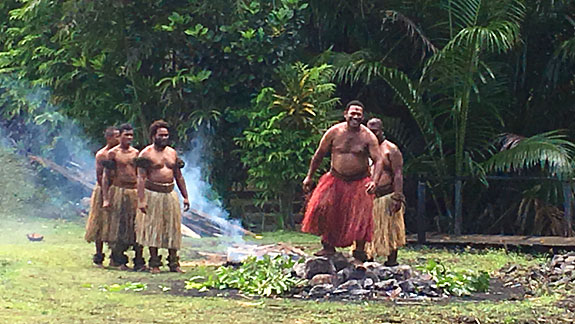
All in all, PARBICA 17 was another huge success. The sessions were very informative and it was fantastic to hear about the amazing projects, programs and updates that are going on all across the Pacific Islands. Digital programs in particular are reaching bigger heights and disseminating information faster and in greater volume more than ever before. As for me individually, it was great to see all my colleagues in one place. I have worked with so many PARBIOCAns over the years, and it was very nice to chat with some that have not seen in a few years. But it was also terrific to meet new people as well with the hope of forming new relationships. This is what a conference is all about: catching up with old colleagues and meeting new ones. I have no doubts that together we will build a more affluent community of archivists and records managers dedicated to promoting, preserving and sharing their unique heritage within the Pacific Islands and the world at large.
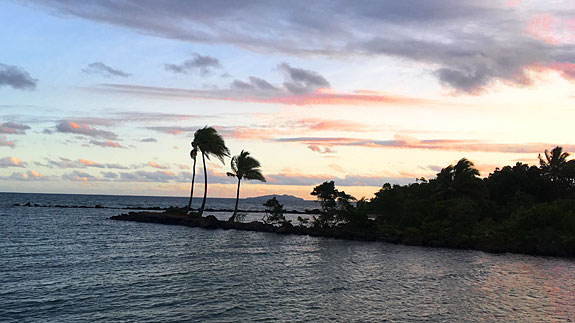
Until PARBICA 18 ... vinaka!
